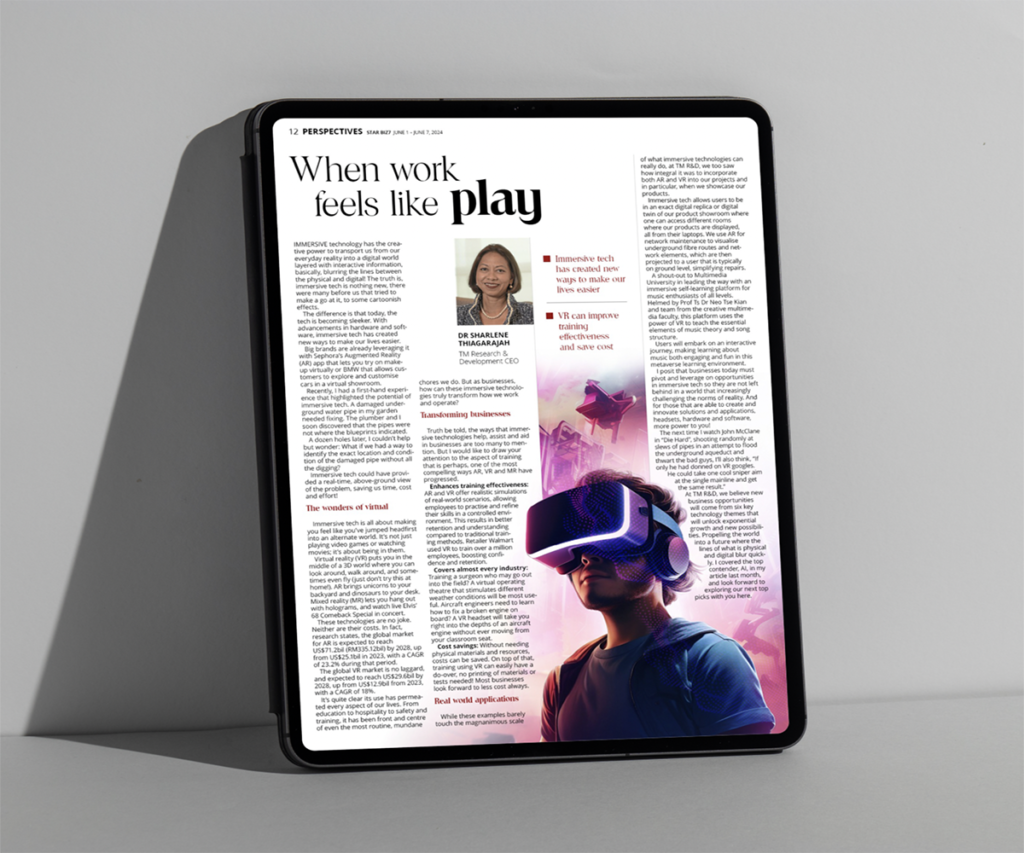
IMMERSIVE technology has the creative power to transport us from our everyday reality into a digital world layered with interactive information, basically, blurring of lines between the physical and digital! The truth is, immersive tech is nothing new, there were many before us that tried to make a go at it, to some cartoonish effects.
The difference is that today, the tech is becoming sleeker. With advancements in hardware and software, immersive tech has created new ways to make our lives easier.
Big brands are already leveraging it with Sephora’s Augmented Reality (AR) app that lets you try on make-up virtually or BMW that allows customers to explore and customise cars in a virtual showroom.
Recently, I had a first-hand experience that highlighted the potential of immersive tech. A damaged underground water pipe in my garden needed fixing. The plumber and I soon discovered that the pipes were not where the blueprints indicated.
A dozen holes later, I couldn't help but wonder: What if we had a way to identify the exact location and condition of the damaged pipe without all the digging?
Immersive tech could have provided a real-time, above-ground view of the problem, saving us time, cost and effort!
The wonders of virtual
Immersive tech is all about making you feel like you’ve jumped headfirst into an alternate world. It’s not just playing video games or watching movies; it’s about being in them.
Virtual reality (VR) puts you in the middle of a 3D world where you can look around, walk around, and sometimes even fly (just don't try this at home!). AR brings unicorns to your backyard and dinosaurs to your desk. Mixed reality (MR) lets you hang out with holograms, and watch live Elvis’ 68 Comeback Special in concert.
These technologies are no joke. Neither are their costs. In fact, research states, the global market for AR is expected to reach US$71.2bil (RM335.12bil) by 2028, up from US$25.1bil in 2023, with a CAGR of 23.2% during that period.
The global VR market is no laggard, and expected to reach US$29.6bil by 2028, up from US$12.9bil from 2023, with a CAGR of 18%.
It's quite clear its use has permeated every aspect of our lives. From education to hospitality to safety and training, it has been front and centre of even the most routine, mundane chores we do. But as businesses, how can these immersive technologies truly transform how we work and operate?
Transforming businesses
Truth be told, the ways that immersive technologies help, assist and aid in businesses are too many to mention. But I would like to draw your attention to the aspect of training that is perhaps, one of the most compelling ways AR, VR and MR has progressed.
Enhances training effectiveness:
AR and VR offer realistic simulations of real-world scenarios, allowing employees to practise and refine their skills in a controlled environment. This results in better retention and understanding compared to traditional training methods. Retailer Walmart used VR to train over a million employees, boosting confidence and retention.
Covers almost every industry:
Training a surgeon who may go out into the field? A virtual operating theatre that stimulates different weather conditions will be most useful. Aircraft engineers need to learn how to fix a broken engine on board? A VR headset will take you right into the depths of an aircraft engine without ever moving from your classroom seat.
Cost savings:
Without needing physical materials and resources, costs can be saved. On top of that, training using VR can easily have a do-over, no printing of materials or tests needed! Most businesses look forward to less cost always.
Real world applications
While these examples barely touch the magnanimous scale of what immersive technologies can really do, at TM R&D, we too saw how integral it was to incorporate both AR and VR into our projects and in particular, when we showcase our products.
Immersive tech allows users to be in an exact digital replica or digital twin of our product showroom where one can access different rooms where our products are displayed, all from their laptops. We used AR for network maintenance to visualise underground fibre routes and network elements, which are then projected to a user that is typically on ground level, simplifying repairs.
A shout-out to Multimedia University in leading the way with an immersive self-learning platform for music enthusiasts of all levels. Helmed by Prof Ts Dr Neo Tse Kian and team from the creative multimedia faculty, this platform uses the power of VR to teach the essential elements of music theory and song structure.
Users will embark on an interactive journey, making learning about music both engaging and fun in this metaverse learning environment.
I posit that businesses today must pivot and leverage on opportunities in immersive tech so you are not left behind in a world that increasingly challenging the norms of reality. And for those that are able to create and innovate solutions and applications, headsets, hardware and software, more power to you!
The next time I watch John McClane in “Die Hard”, shooting randomly at slews of pipes in an attempt to flood the underground aqueduct and thwart the bad guys, I’ll also think, “If only he had donned on VR googles. He could take one cool sniper aim at the single mainline and get the same result.”
At TM R&D, we believe new business opportunities will come from six key technology themes that will unlock exponential growth and new possibilities. Propelling the world into a future where the lines of what is physical and digital blur quickly. I covered the top contender, AI, in my article last month, and look forward to exploring our next top picks with you here.
This article was first published in the Star Biz7, Issue 46 – Funding the economic engine
To access the PDF version, Click Here
To read the full Star Biz7 digital magazine, Click Here

